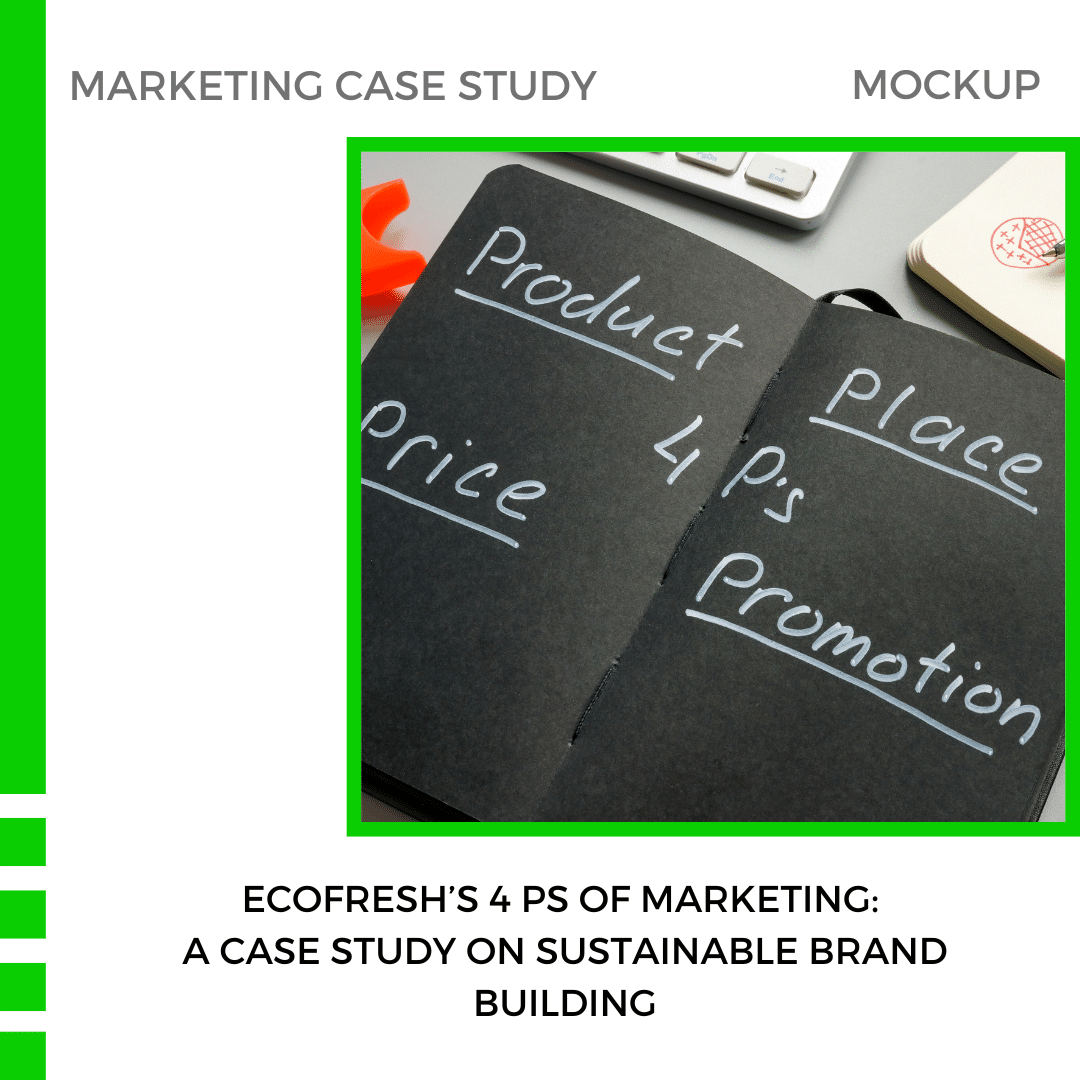
EcoFresh’s 4 Ps of Marketing: A Case Study on Sustainable Brand Building
Introduction
The 4 Ps of Marketing —product, Price, Place, and Promotion—are critical in shaping consumer perception, market share, and brand loyalty. This case study focuses on how EcoFresh, a startup established in 2020, leveraged the four Ps to introduce and expand its eco-friendly line of home cleaning products. By examining EcoFresh’s strategy, we gain insights into the company’s challenges and successes in developing a brand that prioritizes environmental sustainability.
EcoFresh’s story provides a valuable learning opportunity for students to explore how the 4 Ps impact a company’s growth, particularly in niche markets like eco-friendly products. Through this analysis, students will assess EcoFresh’s strategic application of the 4 Ps of marketing, examining what worked and what didn’t and identifying possible improvements.
Objectives:
- Understand the foundational principles of the 4 Ps of marketing.
- Analyze the application of the 4 Ps in a real-world startup context.
- Assess the effectiveness of EcoFresh’s marketing strategies and suggest actionable recommendations to optimize their approach.
Background Information
Key Concepts of the 4 Ps of Marketing:
- Product: Refers to the items or services a company offers to meet consumer needs.
- Price: The cost consumers pay to acquire the product, reflecting its perceived value.
- Place: The methods and channels used to distribute the product to consumers.
- Promotion: Marketing activities designed to communicate product benefits, enhance awareness, and encourage sales.
The Company: EcoFresh
EcoFresh specializes in eco-friendly, non-toxic home cleaning solutions that offer sustainable alternatives to traditional cleaning products. EcoFresh’s product portfolio includes all-purpose cleaners, dish soaps, laundry detergents, and air fresheners, each made with natural ingredients and packaged using recyclable materials. Learn more about EcoFresh’s commitment to sustainability on their official website.
EcoFresh’s Application of the 4 Ps of Marketing
Product
Product Strategy: EcoFresh has designed a product line that aligns with eco-conscious consumer preferences, including recyclable packaging and non-toxic ingredients. The products come in various scents and formulas, catering to needs like sensitive skin or pet-friendliness.
Challenges:
- Effectiveness: Striving to maintain high product effectiveness with only natural ingredients.
- Differentiation: Competing with other eco-friendly brands in a rapidly growing market.
Price
Pricing Strategy: EcoFresh adopts a premium pricing approach, positioning its products as high-quality and environmentally responsible. Although the prices are above average compared to mainstream cleaners, they remain competitive within the eco-friendly segment.
Challenges:
- Value Perception: Balancing premium pricing with consumers’ perceived value.
- Competition: Facing price competition from both conventional and eco-friendly brands.
Place
Distribution Strategy: EcoFresh primarily sells directly to consumers through its e-commerce website and has expanded its reach via platforms like Amazon. While it focuses on online sales, it has a limited presence in physical retail stores, emphasizing health and eco-conscious shops.
Challenges:
- Awareness: Building trust in a primarily online distribution model.
- Retail Expansion: Limited visibility in physical retail, affecting consumer awareness.
Promotion
Promotion Strategy: EcoFresh engages consumers through social media marketing, influencer collaborations, and content marketing. Email campaigns are another key strategy: offering subscribers product tips and exclusive discounts.
Challenges:
- Engagement: Maintaining visibility in a competitive social media landscape.
- Content Consistency: Ensuring consistently engaging content to retain consumer interest.
Case Study Analysis
Task 1: Product Strategy
Product Effectiveness and Differentiation: Students should assess the performance of EcoFresh products compared to conventional and eco-friendly alternatives, incorporating consumer feedback. They should explore possible product improvements, like introducing new scent options or enhancing formula effectiveness for broader consumer appeal.
Task 2: Pricing Strategy
Consumer Price Perception and Competitive Pricing: This task involves evaluating consumer perceptions of EcoFresh’s pricing and its impact on sales. Students should also compare the pricing strategy with competitors, suggesting alternative pricing models or discounts that could attract a wider audience.
Task 3: Distribution Strategy
Online vs. Offline Sales Channels: Evaluate the benefits and drawbacks of EcoFresh’s online-heavy distribution. Students could discuss strategies for increasing visibility in retail outlets and the potential advantages of partnerships with health and eco-conscious stores.
Task 4: Promotion Strategy
Social Media and Content Marketing: Students will analyze EcoFresh’s promotional efforts on social media and through influencers, assessing their effectiveness in building brand awareness. They may propose improvements, such as expanding content themes or leveraging other digital platforms to enhance consumer engagement.
Financial and Market Data for Analysis
Product Sales Data
| Product | Units Sold | Revenue |
|---|---|---|
| All-Purpose Cleaner | 10,000 | $100,000 |
| Laundry Detergent | 8,000 | $96,000 |
| Dish Soap | 7,000 | $56,000 |
| Air Freshener | 5,000 | $40,000 |
Pricing Comparison
| Brand | Product | Price (per unit) |
|---|---|---|
| EcoFresh | All-Purpose Cleaner | $10 |
| Competitor A | All-Purpose Cleaner | $8 |
| Competitor B | All-Purpose Cleaner | $12 |
Distribution Metrics
| Channel | Sales | Growth Rate |
|---|---|---|
| E-commerce Website | $200,000 | 15% |
| Online Marketplaces | $50,000 | 10% |
| Physical Retail Stores | $42,000 | 5% |
Promotion Metrics
| Campaign | Reach | Engagement Rate |
|---|---|---|
| Social Media (Instagram) | 100,000 | 4% |
| Influencer Collaboration | 50,000 | 6% |
| Email Marketing | 20,000 | 10% |
Possible Solution: Optimizing EcoFresh’s 4 Ps of Marketing
Product Enhancement: EcoFresh can expand its product range to include more specialized cleaners or introduce larger bulk options, appealing to eco-conscious consumers looking for more sustainable shopping choices. This strategy could enhance EcoFresh’s differentiation while fostering customer loyalty.
Revised Pricing Strategy: Offering flexible pricing options, such as loyalty discounts or introductory pricing for new customers, could improve value perception. Bundling products at a reduced price may also appeal to budget-conscious consumers without compromising on EcoFresh’s premium image.
Distribution Expansion: Increasing partnerships with physical retailers could broaden EcoFresh’s reach and build brand trust. Collaboration with eco-conscious grocery chains or health stores can help EcoFresh increase visibility among in-store shoppers who value sustainable products.
Promotion Enhancement: Expanding content marketing through educational blog posts on sustainability and eco-friendly living may attract a broader audience. Additionally, diversifying social media channels (such as YouTube for how-to videos) can deepen customer engagement, boosting brand loyalty.
For additional insights into EcoFresh’s sustainable strategies, visit their official website.
Conclusion
This case study of EcoFresh’s application of the 4 Ps of marketing illustrates the strengths and challenges a startup may encounter in a niche market. EcoFresh’s eco-friendly product line resonates with consumers, but opportunities remain for growth in pricing strategy, distribution reach, and promotional methods. By implementing the proposed recommendations, EcoFresh can enhance its position within the competitive eco-friendly market, ultimately achieving greater brand loyalty and expanding its customer base.
Through this analysis, students understand how each element of the 4 Ps of marketing affects brand performance and consumer engagement. The strategies explored in this case study can inspire students to apply the 4 Ps framework effectively in real-world marketing scenarios.
Explore Business Models of Global Companies and Indian Companies
Tag:4 Ps of Marketing, brand differentiation, brand visibility, branding analysis, branding failure, branding success, business case study, case studies, case study, consumer perception, customer perception, distribution strategy, eco-conscious consumers, eco-friendly marketing, eco-friendly products, eco-friendly startup, EcoFresh case study, economics case study, influencer marketing, marketing case study, marketing lessons, marketing mix, marketing mix analysis, marketing strategy, mockup case study, online distribution, premium pricing, pricing strategy, product differentiation, product improvement, product strategy, promotion strategy, retail distribution, social media marketing, student case study, sustainable branding, sustainable products



